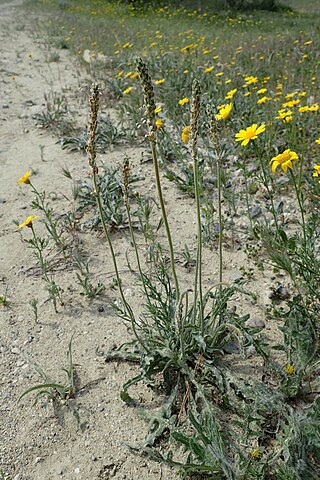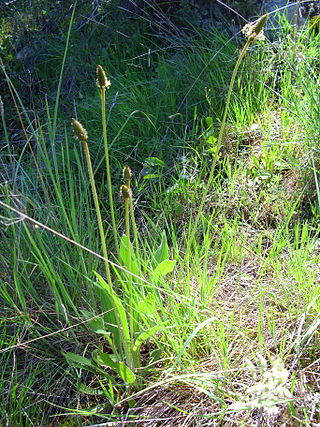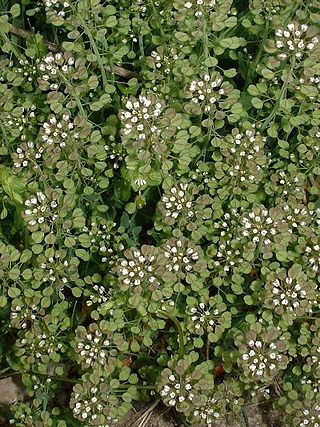
Hypecoum procumbens, the sickle-fruited hypecoum, is a species of annual herb in the family Papaveraceae. They have a self-supporting growth form and simple leaves. Individuals can grow to 40 cm tall.
Hypericum australe is a species of plant in the family Hypericaceae. Individuals can grow to 24 cm tall.

Parietaria lusitanica is a species of plant in the family Urticaceae.

Plantago albicans is a species of perennial herb in the family Plantaginaceae. They have a self-supporting growth form, simple, broad leaves and dry fruit. Individuals can grow to 0.3 m.

Plantago altissima is a species of perennial herb in the family Plantaginaceae. They have a self-supporting growth form and simple, broad leaves. Individuals can grow to 0.58 m.
Plantago bellardii is a species of annual herb in the family Plantaginaceae. They have a self-supporting growth form and simple, broad leaves. Individuals can grow to 4 cm tall.

Plantago lagopus, the hare's foot plantain, is a species of annual herb in the family Plantaginaceae. They have a self-supporting growth form and simple, broad leaves. Flowers are visited by Heliotaurus ruficollis, Malachius, Metopoplax origani, and brown argus. Individuals can grow to 25 cm.

Plantago macrorhiza is a species of perennial herb in the family Plantaginaceae. Individuals can grow to 5 cm.

Plantago serraria is a species of plants in the family Plantaginaceae.

Plantago weldenii is a species of annual herb in the family Plantaginaceae. They have a self-supporting growth form. Individuals can grow to 3.2 cm.

Scorzonera laciniata, also known as cutleaf vipergrass, is a species of herb in the family Asteraceae.

Polypogon viridis, the beardless rabbitsfoot grass, is a species of perennial grass in the family Poaceae. They have a self-supporting growth form and simple, broad leaves. Individuals can grow to 0.43 m. They are native to southern Europe, Macaronesia, North and East Africa, and Asia.
Rumex cristatus, the Greek dock, is a species of perennial herb in the family Polygonaceae.

Sedum rubens is a species of annual herb in the family Crassulaceae. They are succulent plants. They have a self-supporting growth form and simple, broad leaves. Individuals can grow to 5.4 cm.
Sphenopus divaricatus is a species of grass in the family Poaceae.

Tamarix africana, also known as the African tamarisk, is a species of tree in the family Tamaricaceae. They have a self-supporting growth form and simple leaves. Individuals can grow to 6.3 m.

Thlaspi perfoliatum is a species of plants in the family Brassicaceae.

Trifolium lappaceum, the burdock clover, is a species of annual herb in the family Fabaceae. They have a self-supporting growth form and compound, broad leaves.

Trifolium suffocatum, the suffocated clover, is a species of annual herb in the family Fabaceae. They have a self-supporting growth form and compound, broad leaves. Individuals can grow to 4.2 cm.

Trifolium tomentosum, the woolly clover, is a species of annual herb in the family Fabaceae. They have a self-supporting growth form and compound, broad leaves. Individuals can grow to 8.9 cm.















